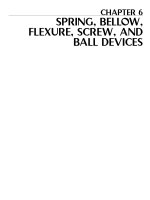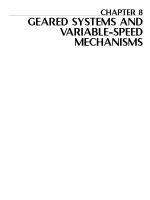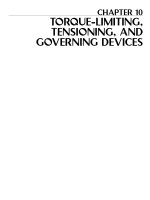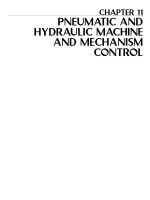Itch Basic Mechanisms and Therapy doc
Bạn đang xem bản rút gọn của tài liệu. Xem và tải ngay bản đầy đủ của tài liệu tại đây (8.77 MB, 395 trang )
Itch
Basic
Mechanisms
and
Therapy
edited
by
Gil Yosipovitch
Wake Forest University School
of
Medicine
Winston-Salem, North Carolina,
U.S.A.
Malcolm
W.
Greaves
University
of
London
London, England
and Singapore General Hospital
Singapore, Republic
of
Singapore
Alan
6.
Fleischer,
Jr.
Wake Forest University School
of
Medicine
Winston-Salem, North Carolina,
U.S.A.
Francis McGlone
Unilever Research and Development
Wirral, England
and University
of
Wales
Bangor, Wales
MARCEL
MARCEL DEKKER,
INC.
a%
DEKKER
NEW
YORK
-
BASEL
Although great care has been taken to provide accurate and current information,
neither the author(s) nor the publisher, nor anyone else associated with this publica-
tion, shall be liable for any loss, damage, or liability directly or indirectly caused or
alleged to be caused by this book. The material contained herein is not intended to
provide specific advice or recommendations for any specific situation.
Trademark notice: Product or corporate names may be trademarks or registered
trademarks and are used only for identification and explanation without intent to
infringe.
Library of Congress Cataloging-in-Publication Data
A catalog record for this book is available from the Library of Congress.
ISBN: 0-8247-4747-X
This book is printed on acid-free paper.
Headquarters
Marcel Dekker, Inc., 270 Madison Avenue, New York, NY 10016, U.S.A.
tel: 212-696-9000; fax: 212-685-4540
Distribution and Customer Service
Marcel Dekker, Inc., Cimarron Road, Monticello, New York 12701, U.S.A.
tel: 800-228-1160; fax: 845-796-1772
Eastern Hemisphere Distribution
Marcel Dekker AG, Hutgasse 4, Postfach 812, CH-4001 Basel, Switzerland
tel: 41-61-260-6300; fax: 41-61-260-6333
World Wide Web
The publisher offers discounts on this book when ordered in bulk quantities. For more
information, write to Special Sales/Professional Marketing at the headquarters
address above.
Copyright nnnn 2004 by Marcel Dekker, Inc. All Rights Reserved.
Neither this book nor any part may be reproduced or transmitted in any form or by
any means, electronic or mechanic al, including photocopying, microfilming, and
recording, or by any information storage and retrieval system, without permission
in writing from the publisher.
Current printing (last digit):
10987654321
PRINTED IN THE UNITED STATES OF AMERICA
BASIC AND CLINICAL DERMATOLOGY
1.
2.
3.
4.
5.
6.
7.
8.
9.
10.
11.
12.
13.
Series
Editors
ALAN
R.
SHALITA,
M.D.
Distinguished Teaching Professor and Chairman
Department of Dermatology
State University of New
York
Health Science Center at Brooklyn
Brooklyn, New
York
DAVID
A. NORRIS,
M.D.
Director of Research
Professor of Dermatology
The University of Colorado
Health Sciences Center
Denver, Colorado
Cutaneous Investigation in Health and Disease: Noninvasive Methods
and Instrumentation,
edited by Jean-Luc Leveque
Irritant Contact Dermatitis,
edited by Edward M. Jackson and Ronald
Goldner
Fundamentals
of
Dermatology: A Study Guide,
Franklin
S.
Glickman and
Alan R. Shalita
Aging Skin: Properties and Functional Changes,
edited by Jean-Luc
Leveque and Pierre G. Agache
Retinoids: Progress in Research and Clinical Applications,
edited by
Maria A. Livrea and Lester Packer
Clinical Photomedicine,
edited by Henry W. Lim and Nicholas
A.
Soter
Cutaneous Antifungal Agents: Selected Compounds in Clinical Practice
and Development,
edited by John W. Rippon and Robert A. Fromtling
Oxidative Stress in Dermatology,
edited by Jurgen Fuchs and Lester
Packer
Connective Tissue Diseases
of
the Skin,
edited by Charles M. Lapiere
and Thomas Krieg
Epidermal Growth Factors and Cytokines,
edited by Thomas
A.
Luger
and Thomas Schwarz
Skin Changes and Diseases in Pregnancy,
edited by Marwali Harahap
and Robert C. Wallach
Fungal Disease: Biology, Immunology, and Diagnosis,
edited by Paul H.
Jacobs and Lexie Nall
lmmunomodulatory and Cytotoxic Agents in Dermatology,
edited by
Charles J. McDonald
14.
15.
16.
,l7.
18.
19.
20.
21.
22.
23.
24.
25.
26.
27.
Cutaneous Infection and Therapy,
edited by Raza Aly, Kart
R.
Beutner,
and Howard
1.
Maibach
Tissue Augmentation in Clinical Practice: Procedures and Techniques,
edited by Arnold William Klein
Psoriasis: Third Edition, Revised and Expanded,
edited by Henry H.
Roenigk, Jr., and Howard
1.
Maibach
Surgical Techniques
for
Cutaneous Scar Revision,
edited by Mamali
Harahap
Drug Therapy in Dermatology,
edited by Lany
E.
Millikan
Scarless Wound Healing,
edited by Hari G. Garg and Michael
T.
Long-
aker
Cosmetic Surgery: An Interdisciplinary Approach,
edited by Rhoda
S.
Narins
Topical Absorption of Dermatological Products,
edited by Robert L.
Bronaugh and Howard
1.
Maibach
Glycolic Acid Peels,
edited by Ronald Moy, Debra Luffman, and Lenore
S.
Kakita
Innovative Techniques in Skin Surgery,
edited by Marwali Harahap
Safe Liposuction,
edited by Rhoda
S.
Narins
Psychocutaneous Medicine,
edited by John
Y.
M.
Koo
and Chai Sue Lee
Skin, Hair, and Nails: Structure and Function,
edited by Bo Forslind and
Magnus Lindberg
Itch: Basic Mechanisms and Therapy,
edited by Gil Yosipovitch, Malcolm
W. Greaves, Alan 8. Fleischer, Jr., and Francis McGlone
ADDITIONAL
VOLUMES
IN
PREPARA
TION
Vitiligo: Problems and Solutions,
edited by Torello Loffi and Jana
Hercogova
Photoaging,
edited by Darrel
S.
Rigel, Robert A. Weiss, Henry W. Lim,
and Jeffrey
S.
Dover
To my wife, Galit, my children, Dan and Natalie,
and my devoted parents, Shifra and Zvi.
Without their continuous support, love, and understanding,
this book would not have been possible.
G. Y.
To all my itchy patients who taught me that there is more
to pruritus than scratching the surface.
M. W. G.
To my wonderful and patient wife, Anne.
A. B. F.
For all those who suffer still, in the hope that our growing knowledge
of the mechanisms will enhance our therapies.
F. M.
Series Introduction
Over the past decade, there has been a vast exp losion in new information
relating to the art and science of dermatology as well as fundamental cuta-
neous biology. Furthermore, this information is no longer of interest only to
the small but growing specialty of dermatology. Scientists from a wide variety
of disciplines have come to recognize both the importance of skin in fun-
damental biological processes and the broad implications of understanding
the pathogenesis of skin disease. As a result, there is now a multidisciplin ary
and worldwide interest in the progress of dermatology.
With these factors in mind, we have undertaken to develop this series of
books specifically oriented to dermat ology. The scope of the series is pur-
posely broad, with books ranging from pure basic scienc e to practical, applied
clinical dermatology. Thus, while there is something for everyone, all volumes
in the series will ultimately prove to be valuable additions to the dermatolo-
gist’s library.
The latest addition to the series, edited by Gil Yosipovitch, Malcolm
Greaves, Alan Fleischer, and Francis McGlone, is both timely and pertinent.
The authors are well-known authorities in the field. We trust that this volume
will be of broad interest to scientists and clinicians alike.
Alan R. Shalita
SUNY Health Science Center
Brooklyn, New York
v
Foreword
You know that I would cut off
My hands to help you
But if I did I wouldn’t have
Anything to scratch with
And then I’d be of
No use at all.
Don McGonigal, ‘‘ The Itch’’ , 1991
Itch is one of the most distressing sensations that substantially impair the
quality of life, and in some cases it may even cause psychological disorders.
It is a symptom of many skin diseases and may be caused by a variety of sys-
temic diseases.
The enormous developments in biotechnology of the past five years
have enabled major progress in neurophysiological research, allowing us to
vii
define novel pathways for itch. Improved understanding of the pathophysi-
ology and molecular basis of itching ultimately has stimulated the search for
and development of novel therapeutic stra tegies. In the current book Drs.
Yosipovitch, Greave s, Fleischer, and McGlone were able to motivate out-
standing scientists and clinicians to provide, in a multidisciplinary approach,
the most current knowledge of the complex experimental, clinical, and
therapeutic aspects of itching. This includes recent research concerning basic
mechanisms of itching such as central nervous aspects, animal and human
models, and neuropeptides as well as their respective receptors. Furthermore,
emphasis is put on new techniques of itch evaluation such as micro dialysis and
questionnaires. Another important topic is the symptom of itch in dermato-
logical as well as systemic diseases. Finally, as a result of our improved
understanding of the pathophysiology of itching, several chapters address the
most up-to-date therapeutic developments, including new drugs and psycho-
logical approaches.
In summ ary, the important insights provided by the expertise of these
outstanding contributors will be of major interest to clinicians managing this
challenging symptom as well as to researchers interested in the pathogenesis
of itching.
Thomas A. Luger, M.D.
Professor and Chairman
Department of Dermatology
University Clinics Mu
¨
nster
Mu
¨
nster, Germany
Forewordviii
Preface
For many years progress in understanding the neuropathophysiology and
molecular basis of itch has been handicapped by a lack of specific and
sensitive investigational methodologies for human subjects and the unsuit-
ability of animal models. Researchers have finally begun to overcome these
difficulties, with important clinical implications. Recent neurophysiological
research has made possible a more accurate description of neural pathways
of itch and has confirmed the distinctiveness of itch pathways in comparison
with pain pathways.
We were motivated to work on this book by consideration of patients
afflicted by chronic and intractable itch and our desire to contribute to a
better understanding of this common, bothersome symptom. The idea was
proposed in October 2001 at the International Workshop for the Study of
Itch in Singapore. This was the first multidisciplinary meeting that brought
clinicians and scientists together to address problems related to itch.
This book presents a concise discussion of the basic aspects of itch,
various diseases in which itch constitutes a major problem, and methods
employed in its diagnosis and management. It is designed to be a source of
ix
information for both dermatologists and nondermatologists who treat itch,
as well as for researchers in the field of neurophysiology and pharmacology.
The organization of the chapters reflects our views as to how the reader can
best utilize these materials. The book has six parts. Part I contains a pro-
posed clinical classification of itch, based on an improved understanding of
its neurophysiology. Part II reviews the basic mechanisms of itch. Part III
addresses the evaluation of the patient with itch. Part IV focuses on epi-
demiology and characteristics of itch in skin and systemic diseases. Part V
provides an overview of the different methods for the treatment of itch cur-
rently in use or in clinical trials. The last part consists of three chapters ad-
dressing the social and psychological aspects of itch.
The authors were selected for their expertise and interest in this field.
While efforts were made to avoid repetition, each author was free to present
his or her own concepts and thoughts. The progress documented in this
book is encouraging and is a direct result of expanded interest in the prob-
lem of itch in both the scientific and clinical communities.
Gil Yosipovitch
Malcolm W. Greaves
Alan B. Fleischer, Jr.
Francis McGlone
Prefacex
Contents
Foreword Thomas A. Luger vii
Preface ix
Contributors xv
Part I. Clinical Classification of Itch
1. Definitions of Itch 1
Gil Yosipovitch and Malcolm W. Greaves
Part II. Basic Mechanisms of Itch
2. Neurophysiologic Basis of Itch 5
Martin Schmelz and Hermann O. Handwerker
3. Pain and Itch 13
Martin Schmelz and Hermann O. Handwerker
4. Central Neural Mechanisms of Itch 21
David Andrew and A. D. Craig
5. Animal Models of Itch: Scratching Away at the Problem 35
Earl Carstens and Yasushi Kuraishi
xi
6. Histamine-Induced Discriminative and Affective
Responses Revealed by Functional MRI 51
Francis McGlone, Roman Rukwied, Matt Howard,
and David Hitchcock
7. Central Nervous System Imaging of Itch with PET 63
Ulf Darsow, Alexander Drzezga, and Johannes Ring
8. Skin Nerve Anatomy: Neuropeptide Distribution and Its
Relationship to Itch 71
Dieter Metze
9. Substance P and Itch 87
Tsugunobu Andoh and Yasushi Kuraish i
10. Peripheral Opiate Receptor System in Human Epidermis
and Itch 97
Paul Lorenz Bigliardi and Mei Bigliardi-Qi
11. Antipruritic Activity of a Novel K-Opioid Receptor
Agonist, TRK-820 107
Jun Utsumi, Yuko Togashi, Hideo Umeuchi, Kiyoshi Okano,
Toshiaki Tanaka, and Hiroshi Nagase
12. Putative Role of Cannabinoids in Experimentally Induced
Itch and Inflammation in Human Skin 115
Roman Rukwied, Melita Dvorak, Allan Watkinson,
and Francis McGlone
13. Itch Models in Animals, with Special Emphasis on the
Serotonin Model in Rats 131
Jens Schiersing Thomsen
14. Human Itch Models, with Special Emphasis on Itch in
SLS-Inflamed and Normal Skin 139
Jens Schiersing Thomsen
Part III. Evaluation of Patients with Itch
15. Microdialysis in Itch Research 147
Martin Schmelz
Contentsxii
16. Measuring Nocturnal Scratching in Atopic Dermatitits 161
Toshiya Ebata
17. Itch Questionnaires as Tools for Itch Evaluation 169
Gil Yosipovitch
Part IV. Epidemiology and Characteristics of Itch
18. Epidemiology of Itching in Skin and Systemic Diseases 183
Gil Yosipovitch
19. Uremic Pruritus: New Perspectives and Insights from
Recent Trials 193
Thomas Mettang, Dominik Mark Alscher,
and Christiane Pauli-Magnus
20. Pruritus Complicating Liver Disease 205
Nora V. Bergasa and E. Anthony Jones
21. Itch in HIV-Infected Patients 219
Maria I. Duque, Gil Yosipovitch, and P. Samuel Pegram
22. Neuropathic Pruritus 231
Gil Yosipovitch, Rashel Goodkin, Ellen Mary Wingard,
and Jeffrey D. Bernhard
23. Clinical Features of Itch in Atopic Eczema 241
Ulf Darsow and Johannes Ring
24. Postburn Itch 247
Robert D. Nelson
25. Pruritus in Lichen Simplex Chronicus and Lichen
Amyloidosis 255
Yung-Hian Leow and Gil Yosipovitch
Part V. Treatment of Itch
26. Treatment of Pruritus in Internal and Dermatological
Diseases with Opioid Receptor Antagonists 259
Sonja Sta
¨
nder and Dieter Metze
Contents xiii
27. Prospects for a Novel K-Opioid Receptor Agonist,
TRK-820, in Uremic Pruritus 279
Hiroo Kumagai, Shigeaki Matsukawa, Jun Utsumi,
and Takao Saruta
28. Treatment of Pruritic Skin Diseases with Topical
Capsaicin 287
Sonja Sta
¨
nder and Dieter Metze
29. Mechanistic and Clinical Assessment of ZangradoRRR,an
Extract of the Amazonian Ethnomedicine Sangre de
Grado, for the Treatment of Itch 305
Mark J. S. Miller, Brian K. Reuter, John L. Wallace,
Keith A. Sharkey, and Paul Bobrowski
30. Reduction in Itch Severity with Topical
Immunomodulators: A New Approach for Patients with
Inflammatory Disease 315
Alan B. Fleischer, Jr.
31. 5-HT
3
Receptor Antagonists as Antipruritics 325
Elke Weisshaar
32. Cutaneous Nerve Stimulation in Treatment of Localized
Itch 335
Joanna Wallengren
Part VI. Social and Psychological Aspects
33. Psychosomatic Aspects of Pruritus 343
Uwe Gieler, Volker Niemeier, Burkhard Brosig, and Jo
¨
rg
Kupfer
34. On Psychological Factors Affecting Reports of Itch
Perception 351
Elia E. Psouni
35. Itching as a Focus of Mental Disturbance 369
Yuval Melamed and Gil Yosipovitch
Index 377
Contentsxiv
Contributors
Dominik Mark Alscher, M.D. Vice Medical Director, Department of Gen-
eral Internal Med icine and Nephrology, Robert-Bosch Hospital, Stuttgart,
Germany
Tsugunobu Andoh, Ph.D. Department of Applied Pharmacology, Toyama
Medical and Pharmaceutical University, Toyama, Japan
David Andrew, B.D.S., Ph.D. Research Fellow, Department of Neuro-
science and Biomedi cal Systems, University of Glasgow, Glasgow, Scotland
Nora V. Bergasa, M.D. Associate Professor, Division of Digestive and Liver
Diseases, Department of Medicine, College of Physicians and Surgeons,
Columbia University, New York, New York, U.S.A.
Jeffrey D. Bernhard, M.D. Professor, Department of Dermatology, Uni-
versity of Massachusetts Medical School, Worcester, Massachusetts, U.S.A.
Paul Lorenz Bigliardi, M.D. Department of Dermatology and Research,
Basel University Hospital, Basel, Swi tzerland
Mei Bigliardi-Qi, Ph.D. Head, Department of Research and Dermatology,
Basel University Hospital, Basel, Swi tzerland
Paul Bobrow ski, B.S. Rainforest Pharmaceuticals, LLC, Scottsdale, Ari-
zona, U.S.A.
xv
Burkhard Brosig, M.D., Ph.D. Clinic for Psychosomatics and Psychother-
apy, Clinic for Psychosomatic Medicine, Un iversity Hospital of Giessen,
Giessen, Germany
Earl Carstens, Ph.D. Professor, Section of Neurobiology, Physiology, and
Behavior, University of California, Davis, Davis, California, U.S.A.
A. D. Craig, Ph.D. Atkinson Pain Research Scientist, Department of
Neurosurgery, Barrow Neurological Institute, Phoenix, Arizona, U.S.A.
Ulf Darsow, M.D. Department of Dermatology and Allergy Biederstein,
Technical University of Munich, Munich, Germany
Alexander Drzezga, M.D. Senior Nuclear Medicine Physician, Department
of Nuclear Medicine, Technical University of Munich, Munich, Germany
Maria I. Duque, M.D. Department of Dermatology, Wake Forest Univer-
sity School of Medicine, Winston-Salem, No rth Carolina, U.S.A.
Melita Dvorak, Ph.D. School of Biological Sciences, University of Man-
chester, Manchester, England
Toshiya Ebata, M.D. Assistant Professor, Department of Dermatology,
Jikei University School of Medicine, Tokyo, Japan
Alan B. Fleischer, Jr., M.D. Professor and Chair, Department of Dermatol-
ogy, Wake Forest University School of Medicine, Winston-Salem, North
Carolina, U.S.A.
Uwe Gieler, M.D. Department of Psychosomatic Dermatology, Clinic for
Psychosomatics and Psychotherapy, Justus-Liebig University, Giessen, Ger-
many
Rashel Goodkin, M.D. Department of Dermatology, Lahey Clinic, Burling-
ton, Massachusetts, U.S.A.
Malcolm W. Greaves, M.D., Ph.D., F.R.C.P. Professor Emeritus, Depart-
ment of Dermatology, University of London, London, England, and Singa-
pore General Hospital, Singapore, Republic of Singapore
Contributorsxvi
Hermann O. Handwerker, M.D., Ph.D. Professor and Chair, Department of
Physiology and Experimental Pathophysiology, University of Erlangen,
Erlangen, Germany
David Hitchcock, Ph.D. Unilever Research and Development, Wirral,
England
Matt Howard, Ph.D. University of Liverpool, Liverpool, England
E. Anthony Jones, M.D., D.Sc., F.R.C.P. Department of Gastrointestinal
and Liver Diseases, Academic Medical Center, Amsterdam, The Netherlands
Hiroo Kumagai, M.D. Assistant Professor, Department of Internal Medi-
cine, Keio University School of Medicine, Tokyo, Japan
Jo
¨
rg Kupfer, Ph.D. Department of Medical Psychology, Justus-Liebig Uni-
versity, Giessen, Germany
Yasushi Kuraishi, Ph.D. Professor, Department of Applied Pharmacology,
Faculty of Pharmaceutical Sciences, Toyama Medical and Pharmaceutical
University, Toyama, Japan
Yung-Hian Leow, M.D., M.Med., F.A.M.S. Senior Consultant Dermatol-
ogist, National Skin Centre, Singapore, Republic of Singapore
Shigeaki Matsukawa, M.D. Director, Department of Internal Medicine,
Inagi Mu nicipal Ho spital, Tokyo, Japan
Francis McGlone, Ph.D. Head and Professor, Cognitive Neuroscience, Uni-
lever Research and Development, Wirral, England, and Associate Director of
the Center for Cognitive Neuroscience, University of Wales, Bangor, Wales
Yuval Melamed, M.D. Deputy Director and Lecturer in Psychiatry, Tel
Aviv Faculty of Medicine, Lev-Hasharon Mental Health Center, Natania,
Israel
Thomas Mettang, M.D., P.D. Vice Medical Director, Department of Gen-
eral Internal Med icine and Nephrology, Robert-Bosch Hospital, Stuttgart,
Germany
Dieter Metze, M.D. Professor, Department of Dermatology, University of
Mu
¨
nster, Mu
¨
nster, Germany
Contributors xvii
Mark J. S. Miller, Ph.D. Professor, Center for Cardiovascular Sciences,
Albany Medical College, Albany, New York, U.S.A.
Hiroshi Nagase, D.Sc. Director, Pharmaceutical Research Laboratories,
Toray Industries, Inc., Kamakura, Kanagawa, Japan
Robert D. Nelson, Ph.D. Director, Surgery Research Laboratory, Depart-
ment of Surgery, Regions Hospital, St. Paul, Minnesota, U.S.A.
Volker Niemeier, M.D. Department of Psychosomatic Dermatology, Clinic
for Psychosomatics and Psychother apy, Justus-Liebig University, Giessen,
Germany
Kiyoshi Okano, Ph.D. Head, First Laboratory of Drug Development,
Pharmaceutical Research Laboratories, Toray Industries, Inc., Kamakura,
Kanagawa, Japan
Christiane Pauli-Magnus, M.D. Department of Clinical Pharmacology and
Toxicology, University Hospital Zurich, Zurich, Switzerland
P. Samuel Pegram , M.D. Professor, Department of Infectious Diseases,
Wake Forest University School of Medicine, Winston-Salem, North Car-
olina, U.S.A.
Elia E. Psouni, B.Sc., M.Sc., Ph.D. Division of Neurophysiology, Depart-
ment of Physiological Sciences, Lund University, Lund, Sweden
Brian K. Reuter, Ph.D. Postdoctoral Fellow, Center for Cardiovascular
Sciences, Albany Medical College, Albany, New York, U.S.A.
Johannes Ring, Prof.Dr.med., Dr.phil. Professor and Director, Department
of Dermatology and Allergy Biederstein, Technical University of Munich,
Munich, Germany
Roman Rukwied, Ph.D. Unilever Research and Development, Wirral, Eng-
land
Takao Saruta, M.D. Professor, Department of Internal Medicine, Nephrol-
ogy and Hypertension, Keio University School of Medicine, Tokyo, Japan
Martin Schmelz, M.D., Ph.D. Department of Anesthesiology Mannheim,
University of Heidelberg, Mannheim, Germany
Contributorsxviii
Keith A. Sharkey, Ph.D. Professor, Neurosciences Research Group, Uni-
versity of Calgary, Calgary, Alberta, Canada
Sonja Sta
¨
nder, M.D. Department of Dermatology, University of Mu
¨
nster,
Mu
¨
nster, Germany
Toshiaki Tanaka, Ph.D. Head, Drug Discovery Laboratory, Pharmaceut-
ical Research Laboratories, Toray Industries, Inc., Kamakura, Kanagawa,
Japan
Jens Schiersing Thomsen, M.D., Ph.D. Department of Dermatology, Gen-
tofte University Hospital, Copenhagen, Denmark
Yuko Togashi, M.Sc. Pharmaceutical Research Laboratories, Toray Indus-
tries, Inc., Kamakura, Kanagawa, Japa n
Hideo Umeuchi, M.S. First Laboratory of Drug Development, Pharma-
ceutical Research Laboratories, Toray Industries, Inc., Kamakura, Kana-
gawa, Japan
Jun Utsumi, V.M.D., D.Sc. General Manager, Corporate Research Plan-
ning Dep artment, Toray Industries, Inc., Tokyo, Japan
John L. Wallace, Ph.D. Professor, Depart ments of Pharmacology and
Medicine, University of Calgary, Calgary, Alberta, Canada
Joanna Wallengren, M.D., Ph.D. Associate Professor, Depart ment of Der-
matology, University Hospital, Lund, Sweden
Allan Watkinson, Ph.D. Unilever Research and Development, Wirral,
England
Elke Weisshaar, M.D. Consultant, Occupational and Environmental Der-
matology, Department of Social Medicine, University of Heidelberg, Heidel-
berg, Germany
Ellen Mary Wingard, M.D. Department of Dermatology, University of
Massachusetts Medical School, Worcester, Massachusetts, U.S.A.
Gil Yosipovitch, M.D. Associate Professor of Dermatology and Neuro-
science, Department of Derm atology, and Neuroscience Center, Wake Forest
University School of Medicin e, Winston-Salem, North Carolina, U.S.A.
Contributors xix
1
Definitions of Itch
Gil Yosipovitch
Wake Forest University School of Medicine, Winston-Salem,
North Carolina, U.S.A.
Malcolm W. Greaves
University of London, London, England, and Singapore General Hospital,
Singapore, Republic of Singapore
The simple de finition of itch first proposed by Samuel Hafenreffer (1) 340
years ago as ‘‘ an unpleasant sensation provoking the desire to scratch’’ is
still widely used; however, as indicated by Savin (2), it is unsatisfactory
because unpleasant is a subjective adjective and is not a descriptor capable
of precise definition. We also wish to point out that many subjects rub but
do not scratch in response to itch. The well-known sign of polished finger-
nails bears witness to this fact, as does the familiar observation that patients
with urticaria, a severely pruritic disorder, almost never have scratch marks.
Although a satisfactory definition of itch remains elusive, at least to
us, it is worth attempting operational definitions of different types of itch for
the assistance of those working in this difficult field.
As with any other subjective symptom, definitions pose problem s. They
serve as an operational framework and we do not intend to constrain updates
in the future. The terms and definitions are not meant to be a comprehensive
glossary but rather a standard glossary for people who work in the fie ld of
itch.
1
Acute itch. An unpleasant sensation which provokes the desire to
scratch for a limited period of time ranging from seconds to a week. It is
elicited by substantial inflammation or injury of body tissue and activation
of pruritoceptive fibers at the site of local tissue damage. This alters the re-
sponse of pruritoceptives, their central connections, and the autonomic ner-
vous system in the region. The report of itch can stop long before healing
has completed. The patient can still have erythema and eczema even though
the itch has subsided. This type of itch is seen after insect bites, acute
dermatitis, and some skin diseas es.
Itch that persists for weeks, months, or years is not classified under
this category.
Chronic itch. Chronic itch differs from acute itch because therapies
that provide transient itch relief do not resolve the underlying pathological
process. Chronic itch will continue when treatment stops. Chroni c itch cor-
rodes the spirit and the quality of life. It may totally destroy a patient’s
social life and even lead to suicide as in patients with chronic pain.
Because chronic itch is unrelenting, affective and environmental stress
factors, such as heat and dryness, may exacerbate the intensity and per-
sistence of itch. Medical treatment would be helpful to prevent or reduce the
itch and to shorten the duration of inflammation and thereby shorten itch.
Intractable itch. This itch cannot be treated in the generally accepted
course of medical practice. A more detailed definition for intractable itch is
‘‘ a chronic itch state in which the cause cannot be removed or otherwise
treated, and in the generally accepted course of medical practi ce no relief or
cure of the cause of itch is possible or none has been found after reasonable
efforts.’’ This definition communicates a message of hopelessness, especially
when we state that chronic itch is treatable. It is important to acknowledge
that such patients are encountered weekly in dermatology clinics, and they
do suffer. In these cases, a more holistic approach is required by an inter-
disciplinary team, with the involvement of both patients and their families.
It integrates pharmacologic and nonpharmacologic treatment with needed
psychotherapy and rehabilitation.
Alloknesis. This type of itch is due to an innocuous stimulus which
does not normally provoke itch (3). This term is derived from the term
allodynia, which is pain due to a stimulus which does not normally invoke
pain. It is important to recognize that alloknesis involves a change in the
quality of a sensation, whether tactile, mechanical, or of any other sort. The
original modality is normally nonitchy, but the response is itchy. It has been
described in atopic eczema after slight mechanical stimulation with wool
fibers in a noninvolved area surrounding an itching lesion. Another common
Yosipovitch and Greaves2
clinical example in patients with atopic eczema is sweat, which prompts in-
tense itching, especially in front of the neck and flexural areas.
Alloknesis has also been demonstrated in experimental itch models in
humans by intracutaneous and subcutaneous injections of histamine (3,
4). Most probably, it can be demonstrated in other itchy dermatosis and
in neuropathic itch, but there are as yet no reported instances of such
demonstrations.
I. CLASSIFICATION OF DIFFERENT TYPES OF ITCH
Recently, a definition of different types of itch was provided (5,6). This may
help us to evaluate and treat itch in a more meaningful way both for the
individual patient and for the comparison of potential therapies in studies.
Pruritoceptive itch. Itch originating in the skin due to inflammation,
dryness, or other skin damage. Examples include itch due to xerosis, urti-
caria, insect bite reactions, and scabies, to name a few.
Neuropathic itch. Itch due to pathology located at any point along
the afferent pathway. Examples include postherpetic neuralgic itch, brach-
ioradial itch, itch associated with cerebral vascular events in the CNS, itch
associated with multiple sclerosis and brain tumors (see Chapter 22).
Neurogenic itch. Itch that originates centrally but without evidence
of neural pathology, exemplified by itch of cholestasis due to the action of
opioid neuropeptides on opioid recept ors (see Chapter 10).
Psychogenic itch. Itch associated with psychological abnormalities,
e.g., itch in a delusional stat e of parasitophobia or itch in a compulsive
disorder (7).
Of course, there is no reason why one type of itch may not coexist
concurrently with another in a given patient, e.g., itch in a patient with
prurigo nodularis, where there could be both a pruritoceptive itch as well as
a neurogenic itch involved.
REFERENCES
1. Hafenreffer S. Nosodochium, in quo cutis, eique adaerentium partium, affectus
omnes, singulari methodo, et cognoscendi e curandi fidelisime traduntur. Ulm:
Ku
¨
hnen, 1660:98–102.
2. Savin J. How should we define itching? J Am Acad Dermatol 1998; 39:268–269.
3. Simone DA, Alreja M, LaMotte RH. Psychophysical studies of the itch sensation
Definitions of Itch 3
and itchy skin (‘‘ alloknesis’’ ) produced by intracutaneous injection of histamine.
Somatosens Mot Res 1991; 8:271–279.
4. Heyer G, Groene D, Martus P. Efficacy of naltrexone on acetylcholine-induced
alloknesis in atopic eczema. Exp Dermatol 2002; 11:448–455.
5. Twycross R, Greaves MW, Handwerker H, et al. Itch: scratching more than the
surface. Q J Med 2003; 96:7–26.
6. Yosipovitch G, Greaves M, Schmelz M. Itch. Lancet 2003; 361:690–694.
7. Bernhard JD. Neurogenic pruritus and strange sensations. In: Bernhrad JD, ed.
Itch Mechanisms and Management of Pruritus. New York: McGraw Hill,
1994:185–202.
Yosipovitch and Greaves4
2
Neurophysiologic Basis of Itch
Martin Schmelz
University of Heidelberg, Mannheim, Germany
Hermann O. Handwerker
University of Erlangen, Erlangen, Germany
I. ITCH PATHWAYS
Low-level activation in nociceptors has been proposed to initiate the itch
sensation, whereas upon higher discharge frequency, the sensation switches to
pain ( intensity theory ). In line with this theory, the application of high concen-
trations of pruritics, e.g., histamine, may be painful. However, low concen-
trations of algogens do not generally cause itch, but less intense pain. The
most convincing argument against the intensity theory was generated using
intraneural microstimulation in afferent nerves in humans: electrical stimu-
lation via a microelectrode implanted in an afferent nerve of volu nteers
induced either the threshold sensation of pain or, more rarely, the sensation
of itch. Increasing the stimulation frequency increased the magnitude of pain
or of itch. No switch of the sensation from itch to pain was observed .
Likewise, the decrease of stimulation frequency at a painful site decreased
the magnitude of pain, but did not induce the sensation of itch (1). According
to t hese results, fir ing frequenc y in nociceptors cannot account for the
differentiation between pain and itch. Thus, it has to be assumed that pruritics
preferentially excit e a certain subgroup of nociceptors which give rise to the
itch sensation. However, the most common type of C-fibers, the mechanoheat
5









